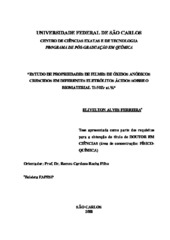| dc.contributor.author | Ferreira, Elivelton Alves | |
| dc.date.accessioned | 2016-06-02T20:34:07Z | |
| dc.date.available | 2008-08-21 | |
| dc.date.available | 2016-06-02T20:34:07Z | |
| dc.date.issued | 2008-05-27 | |
| dc.identifier.citation | FERREIRA, Elivelton Alves. Study of the properties of anodic oxide films grown in different acid electrolytes on the biomaterial Ti-50Zr at.%. 2008. 157 f. Tese (Doutorado em Ciências Exatas e da Terra) - Universidade Federal de São Carlos, São Carlos, 2008. | por |
| dc.identifier.uri | https://repositorio.ufscar.br/handle/ufscar/6093 | |
| dc.description.abstract | Studies on the influence of the nature of the growth electrolyte on the properties of oxide films grown on the Ti-50Zr at.% alloy were carried out. The results obtained through the different measurements done (chronoamperometry, open circuit potentials, and reconstruction rates) showed that phosphate incorporation into the matrix of oxide films grown in H3PO4 make them unstable, bringing a greater dissolution compared to the ones grown in CH3SO3H, H2SO4, and HNO3. The electrochemical impedance spectroscopy measurements showed that the phosphate incorporation into the oxide films grown on the Ti-50Zr at.% alloy by different methods and thickenesses lead to high values of electrical resistance when compared with the ones of films grown in CH3SO3H, H2SO4, and HNO3. The nature of the growth electrolyte was observed to also affect the semiconducting properties of the different oxide films grown on the alloy, leading to different voltammetric profiles of these films when illuminated with radiation of energy greater than that of the band gap. The studies on the effect of the exchange of the electrolyte solution in the galvanostatic growth of anodic films in two steps showed that the breakdown potentials are dependent on the nature of the electrolyte. On the other hand, these measurements also revealed that the initial electrical breakdown of the film or the nature of the electrolyte in which it was initially grown do not alter the film growth kinetics during the second step, carried out in another electrolyte. | eng |
| dc.description.sponsorship | Universidade Federal de Minas Gerais | |
| dc.format | application/pdf | por |
| dc.language | por | por |
| dc.publisher | Universidade Federal de São Carlos | por |
| dc.rights | Acesso Aberto | por |
| dc.subject | Eletroquímica | por |
| dc.subject | Liga Ti-50Zr at.% | por |
| dc.subject | Biomaterial | por |
| dc.subject | Óxidos anódicos | por |
| dc.subject | Fotoeletroquímica | por |
| dc.subject | Espectroscopia de impedância eletroquímica | por |
| dc.title | Estudo de propriedades de filmes de óxidos anódicos crescidos em diferentes eletrólitos ácidos sobre o biomaterial Ti-50Zr at.% | por |
| dc.title.alternative | Study of the properties of anodic oxide films grown in different acid electrolytes on the biomaterial Ti-50Zr at.% | eng |
| dc.type | Tese | por |
| dc.contributor.advisor1 | Rocha Filho, Romeu Cardozo | |
| dc.contributor.advisor1Lattes | http://genos.cnpq.br:12010/dwlattes/owa/prc_imp_cv_int?f_cod=K4780533J3 | por |
| dc.description.resumo | Foram realizados estudos da influência da natureza do eletrólito de crescimento nas propriedades de filmes de óxido crescidos sobre a liga Ti-50Zr at.%. Os resultados obtidos por meio das diferentes medidas realizadas (cronoamperometria, potencial de circuito aberto e taxas de reconstrução) mostraram que a incorporação de fosfato na matriz dos filmes de óxido crescidos em H3PO4 provoca instabilidade dos mesmos, fazendo com que haja maior dissolução em relação aos crescidos em CH3SO3H, H2SO4 e HNO3. As medidas de espectroscopia de impedância eletroquímica mostraram que a incorporação de fosfato na matriz dos filmes de óxido crescidos sobre a liga Ti- 50Zr at.% por diferentes métodos e espessuras proporciona elevados valores de resistência elétrica quando comparados com os de filmes crescidos em CH3SO3H, H2SO4 e HNO3. Foi observado que a natureza do eletrólito de crescimento afeta também as propriedades semicondutoras dos diferentes filmes de óxido crescidos sobre a liga, proporcionando diferentes perfis voltamétricos destes filmes quando iluminados com radiação de energia maior que a da banda proibida. Os estudos do efeito da troca da solução eletrolítica no crescimento por via galvanostática de filmes anódicos em duas etapas mostraram que os potenciais de ruptura são dependentes da natureza do eletrólito. Por outro lado, estas medidas também revelaram que a ruptura elétrica inicial do filme de óxido ou a natureza do eletrólito em que ele foi inicialmente crescido não alteraram a cinética de crescimento durante a segunda etapa, feita em um outro eletrólito. | por |
| dc.publisher.country | BR | por |
| dc.publisher.initials | UFSCar | por |
| dc.publisher.program | Programa de Pós-Graduação em Química - PPGQ | por |
| dc.subject.cnpq | CIENCIAS EXATAS E DA TERRA::QUIMICA | por |
| dc.contributor.authorlattes | http://lattes.cnpq.br/9791486511562981 | por |
